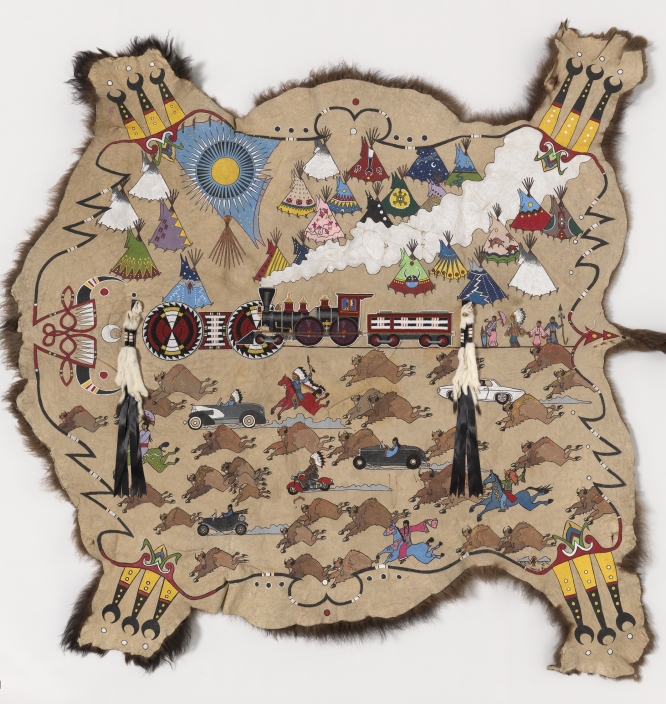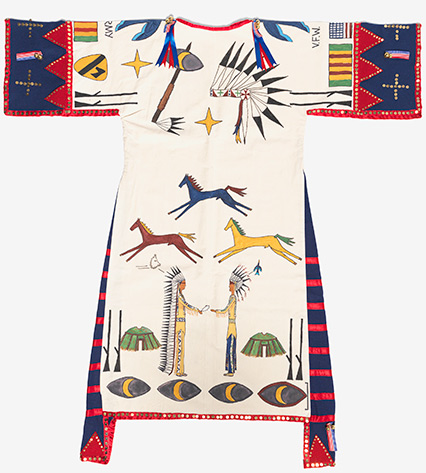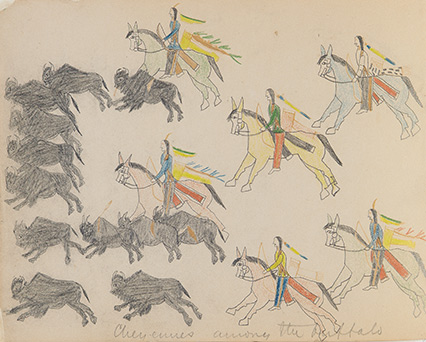 |
Canku Ota
|
 |
|
(Many Paths)
|
||
|
An Online Newsletter
Celebrating Native America
|
||
|
April 2016 - Volume
14 Number 4
|
||
|
|
||
|
"Unbound: Narrative
Art Of The Plains"
|
||
|
by NMAI press release
|
||
|
The National Museum of the American Indian’s George Gustav Heye Center in New York’s exhibition “Unbound: Narrative Art of the Plains” opens March 12 and continues through Dec. 4 in the museum’s East Gallery; admission is free. “Unbound” reflects the dynamic tradition of narrative art among Native Nations of the Great Plains. The exhibition traces the evolution of the art form from historic hides, muslins and ledger books to a wide selection of contemporary works by Native artists, the majority commissioned by the museum exclusively for this exhibition.
Exhibition Facts
Exhibition Sections From Past to Present: Viewed together, Plains narrative artworks from the past and present reflect a strong sense of cultural identity. As life on the plains changed, artists used pictorial storytelling to record the past and preserve their culture. Hallmarks of the narrative or ledger art form—representational figures, strong solid colors, events shown in sequence and stylized symbols—are visible throughout this exhibition. Whether working 150 or five years ago, Native artists have used this style to express what is important in their personal and communal lives. Warrior Art: Male warrior-artists traditionally painted tipis, buffalo robes and shirts with scenes of accomplishments such as taking horses, killing enemies or rescuing wounded comrades. These depictions served as public reminders and as validation. In the 1800s, as the buffalo were decimated, artists increasingly used cloth rather than hide. Paper also became widely available through drawing and ledger books. Warrior-artists used the new media to provide intricate chronicles of their own and others’ exploits. Often created with factory-made pens, pencils, brushes, ink, crayons and watercolor, such drawings provided a means of cultural continuity during the early years of the reservation era (1870–1920). Around the turn of the 20th century, many artists entered boarding schools and were introduced to Western-oriented styles. As a result, the production of narrative art declined. Contemporary Expressions: The 1960s saw a resurgence of Native-led art. The establishment in 1962 of the Institute of American Indian Arts in Santa Fe, N.M., encouraged new expressions informed and inspired by cultural traditions. Ledger art flourished and was widely collected in the 1960s and 1970s. Today men and women artists draw upon their cultural traditions, personal experiences and artistic sensibilities as they continue to shape the Plains narrative style. In 2012, the National Museum of the American Indian commissioned new works from 11 prominent narrative artists. Artists were selected from Native nations that traditionally practiced pictorial storytelling. With no limits on theme or approach, each artist created works that embody his or her distinctive style and voice. Programming Though historically associated mostly with male artists, many women are now known for their fine ledger art. “Crossing Lines: Women and Ledger Art” examines the historical role of women artists within the narrative tradition by welcoming Giago, Growing Thunder-Fogarty and Wakeah Jhane (Comanche/Blackfeet/Kiowa) as they illuminate their own unique backgrounds and motivations as storyteller artists. The event coincides with the exhibition’s public opening Saturday, March 12, and takes place from 11 a.m. to 4:30 p.m. in the museum’s rotunda.
The museum’s Annual Children’s Festival, held Saturday, April 30, and Sunday, May 1, will feature fun and games developed for Native children living on the Great Plains of North America. Many of these activities were more than pastimes and helped teach children survival skills. Activities include the ring and pin game and hoop throw, decorating a parfleche and creating a T-dress doll. Visitors will also hear stories of the Plains, explore the museum’s handling collection and be invited to join interactive dance experiences. The event takes place from noon to 5 p.m. each day. Admission to all programs is free. About the National Museum of
the American Indian |
|||||||
|
|
|
||
|
|
||
| Canku Ota is a free Newsletter celebrating Native America, its traditions and accomplishments . We do not provide subscriber or visitor names to anyone. Some articles presented in Canku Ota may contain copyright material. We have received appropriate permissions for republishing any articles. Material appearing here is distributed without profit or monetary gain to those who have expressed an interest. This is in accordance with Title 17 U.S.C. Section 107. | ||
|
Canku Ota is a copyright ©
2000 - 2016 of Vicki Williams Barry and Paul Barry.
|
||
 |
 |
|
|
The "Canku
Ota - A Newsletter Celebrating Native America" web site and
its design is the
|
||
|
Copyright ©
1999 - 2016 of Paul C. Barry.
|
||
|
All Rights Reserved.
|
||


